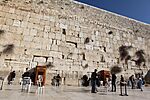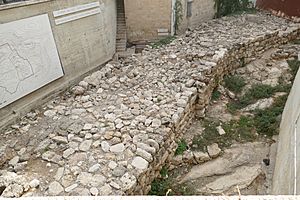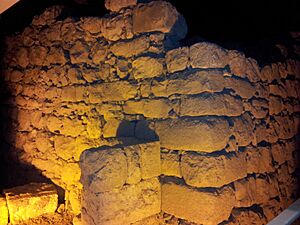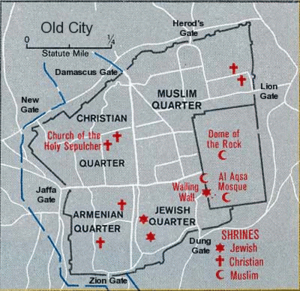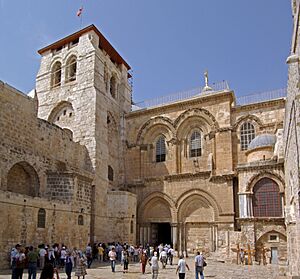Old City of Jerusalem facts for kids
| UNESCO World Heritage Site | |
|---|---|
|
Clockwise from top:
|
|
| Location | East Jerusalem |
| Criteria | Cultural: ii, iii, vi |
| Inscription | 1981 (5th Session) |
| Endangered | 1982–present |
The Old City of Jerusalem (Arabic: المدينة القديمة, romanized: al-Madīna al-Qadīma, Hebrew: הָעִיר הָעַתִּיקָה, romanized: Ha'ír Ha'atiká) is a 0.9-square-kilometre (0.35 sq mi) walled area in East Jerusalem.
In a tradition that may have begun with an 1840s British map of the city, the Old City is divided into four uneven quarters: the Muslim Quarter, the Christian Quarter, the Armenian Quarter, and the Jewish Quarter. A fifth area, the Temple Mount, known to Muslims as Al-Aqsa or Haram al-Sharif, is home to the Dome of the Rock, the Al-Aqsa Mosque, and was once the site of the Jewish Temple.
The Old City's current walls and city gates were built by the Ottoman Empire from 1535 to 1542 under Suleiman the Magnificent. The Old City is home to several sites of key importance and holiness to the three major Abrahamic religions: the Temple Mount and the Western Wall for Judaism, the Church of the Holy Sepulchre for Christianity, and the Dome of the Rock and al-Aqsa Mosque for Islam. The Old City, along with its walls, was added to the World Heritage Site list of UNESCO in 1981.
In spite of its name, the Old City of Jerusalem's current layout is different from that of ancient times. Most archeologists believe that the City of David, an archaeological site on a rocky spur south of the Temple Mount, was the original settlement core of Jerusalem during the Bronze and Iron Ages. At times, the ancient city spread to the east and north, covering Mount Zion and the Temple Mount. The Old City as defined by the walls of Suleiman is thus shifted a bit northwards compared to earlier periods of the city's history, and smaller than it had been in its peak, during the late Second Temple period. The Old City's current layout has been documented in significant detail, notably in old maps of Jerusalem over the last 1,500 years.
Until the mid-19th century, the entire city of Jerusalem, with the exception of David's Tomb complex, was enclosed within the Old City walls. The departure from the walls began in the 19th century, when the city's municipal borders were expanded to include Arab villages such as Silwan and new Jewish neighborhoods such as Mishkenot Sha'ananim. The Old City came under Jordanian control following the 1948 Arab–Israeli War. During the 1967 Six-Day War, Israel occupied East Jerusalem; since then, the entire city has been under Israeli control. Israel unilaterally asserted in its 1980 Jerusalem Law that the whole of Jerusalem was Israel's capital. In international law, East Jerusalem is defined as territory occupied by Israel.
Population
In 1967, the Old City contained 17,000 Muslims, 6,000 Christians (including Armenians) and no Jews.
The current population of the Old City resides mostly in the Muslim quarter. In 2007, the total population was 36,965; there were 27,500 Muslims (growing to over 30,000 by 2013); 5,681 non-Armenian Christians, 790 Armenians (who decreased in number to about 500 by 2013); and 3,089 Jews (with almost 3,000 plus some 1,500 yeshiva students by 2013). By 2020, Old City's population dropped to 31,120.
History
Israelite period
According to the Hebrew Bible, before King David's conquest of Jerusalem in the 11th century BCE the city was home to the Jebusites. The Bible describes the city as heavily fortified with a strong city wall, a fact confirmed by archaeology. The Bible names the city ruled by King David as the City of David, in Hebrew Ir David, which was identified southeast of the Old City walls, outside the Dung Gate. In the Bible, David's son, King Solomon, extended the city walls to include the Temple and Temple Mount. After the partition of the United Kingdom of Israel, the southern tribes remained in Jerusalem, with the city becoming the capital of the Kingdom of Judah.
Jerusalem was largely extended westwards after the Neo-Assyrian destruction of the northern Kingdom of Israel and the resulting influx of refugees. King Hezekiah had been preparing for an Assyrian invasion by fortifying the walls of the capital, building towers, and constructing a tunnel to bring fresh water to the city from a spring outside its walls. He made at least two major preparations that would help Jerusalem to resist conquest: the construction of the Siloam Tunnel, and construction of the Broad Wall.
The First Temple period ended around 586 BCE, as Nebuchadnezzar's Neo-Babylonian Empire conquered Judah and Jerusalem, and laid waste to Solomon's Temple and the city.
Second Temple period
In 538 BCE, the Persian King Cyrus the Great invited the Jews of Babylon to return to Judah to rebuild the Temple. Construction of the Second Temple was completed in 516 BCE, during the reign of Darius the Great, 70 years after the destruction of the First Temple.
In about 440 BCE, the city was rebuilt on a smaller scale during the Persian period, when, according to the Bible, Nehemiah led the Jews who returned from the Babylonian Exile. An additional, so-called Second Wall, was built by King Herod the Great, who also expanded the Temple Mount and rebuilt the Temple. In 41–44 CE, Agrippa, king of Judea, started building the so-called "Third Wall" around the northern suburbs. The entire city was totally destroyed by the Romans in 70 CE.

Late Roman, Byzantine, and Early Muslim periods
The northern part of the city was rebuilt by the Emperor Hadrian around 130, under the name Aelia Capitolina. In the Byzantine period Jerusalem was extended southwards and again enclosed by city walls.
Muslims occupied Byzantine Jerusalem in the 7th century (637 CE) under the second caliph, `Umar Ibn al-Khattab who annexed it to the Islamic Arab Empire. He granted its inhabitants an assurance treaty. After the siege of Jerusalem, Sophronius welcomed `Umar, allegedly because, according to biblical prophecies known to the Church in Jerusalem, "a poor, but just and powerful man" would rise to be a protector and ally to the Christians of Jerusalem. Sophronius believed that `Umar, a great warrior who led an austere life, was a fulfillment of this prophecy. In the account by the Patriarch of Alexandria, Eutychius, it is said that `Umar paid a visit to the Church of the Holy Sepulchre and sat in its courtyard. When the time for prayer arrived, however, he left the church and prayed outside the compound, in order to avoid having future generations of Muslims use his prayer there as a pretext for converting the church into a mosque. Eutychius adds that `Umar also wrote a decree which he handed to the Patriarch, in which he prohibited Muslims gathering in prayer at the site.

Crusader & Ayyubid periods
In 1099, Jerusalem was captured by the Western Christian army of the First Crusade and it remained in their hands until recaptured by the Arab Muslims, led by Saladin, on October 2, 1187. He summoned the Jews and permitted them to resettle in the city. In 1219, the walls of the city were razed by Sultan Al-Mu'azzam of Damascus; in 1229, by treaty with Egypt, Jerusalem came into the hands of Frederick II of Germany. In 1239 he began to rebuild the walls, but they were demolished again by Da'ud, the emir of Kerak. In 1243, Jerusalem came again under the control of the Christians, and the walls were repaired. The Khwarazmian Turks took the city in 1244 and Sultan Malik al-Muazzam razed the walls, rendering it again defenseless and dealing a heavy blow to the city's status.
Ottoman period
The current walls of the Old City were built in 1535–42 by the Ottoman Turkish sultan Suleiman the Magnificent. The walls stretch for approximately 4.5 km (2.8 miles), and rise to a height of between 5 and 15 metres (16.4–49 ft), with a thickness of 3 metres (10 feet) at the base of the wall. Altogether, the Old City walls contain 35 towers, of which 15 are concentrated in the more exposed northern wall. Suleiman's wall had six gates, to which a seventh, the New Gate, was added in 1887; several other, older gates, have been walled up over the centuries. The Golden Gate was at first rebuilt and left open by Suleiman's architects, only to be walled up a short while later. The New Gate was opened in the wall surrounding the Christian Quarter during the 19th century. Two secondary gates were reopened in recent times on the southeastern side of the city walls as a result of archaeological work.
UNESCO status
In 1980, Jordan proposed that the Old City be listed as a UNESCO World Heritage Site. It was added to the List in 1981. In 1982, Jordan requested that it be added to the List of World Heritage in Danger. The United States government opposed the request, noting that the Jordanian government had no standing to make such a nomination and that the consent of the Israeli government would be required since it effectively controlled Jerusalem. In 2011, UNESCO issued a statement reiterating its view that East Jerusalem is "part of the occupied Palestinian territory, and that the status of Jerusalem must be resolved in permanent status negotiations."
Archaeology
Israelite period
Among the Israelite period finds in the Old City are two portions of the 8th and 7th century BCE city walls, in the area of the Israelite Tower, probably including parts of a gate where numerous projectiles were found, attesting to the Babylonian sack of Jerusalem in 586 BCE. Another part of the late 8th-century BCE fortification discovered was dubbed the "broad wall", after the way it was described in the Book of Nehemiah, built to defend Jerusalem against the Assyrian siege of Jerusalem of 701 BCE.
Hellenistic period
In 2015, archaeologists uncovered the remnants of an impressive fort, built by Greeks in the center of old Jerusalem. It is believed that it is the remnants of the Acra fortress. The team also found coins that date from the time of Antiochus IV to the time of Antiochus VII. In addition, they found Greek arrowheads, slingshots, ballistic stones and amphorae.
In 2018, archaeologists discovered a 4-centimeter-long filigree gold earring with a ram's head around 200 meters south of the Temple Mount. The Israel Antiquities Authority said it was consistent with jewelry from the early Hellenistic period (3rd or early 2nd century BCE). Adding that it was the first time somebody finds a golden earring from the Hellenistic times in Jerusalem.
Herodian period
Many structures dated to the Herodian period were discovered in the Jewish Quarter during archaeological excavations carried out between 1967 and 1983. Among them was unearthed a palatial mansion from the Herodian period, believed to be the residence of Annas the High Priest. In its vicinity, a depiction of the Temple menorah was discovered, carved while its model still stood in the Temple, engraved in a plastered wall. The palace has been destroyed during the final days of the Roman siege of 70 CE, suffering the same fate as the so-called Burnt House, a building belonging to the Kathros priestly family, which was found nearby.
In 1968, the Trumpeting Place inscription was found at the southwest corner of Temple Mount, and is believed to mark the site where the priests used to declare the advent of Shabbat and other Jewish holidays.
Byzantine period
In the 1970s, while excavating the remains of the Nea Church (the New Church of the Theotokos), a Greek inscription was found. It reads: "This work too was donated by our most pious Emperor Flavius Justinian, through the provision and care of Constantine, most saintly priest and abbot, in the 13th year of the indiction." A second dedicatory inscription bearing the names of Emperor Justinian and of the same abbot of the Nea Church was discovered in 2017 among the ruins of a pilgrim hostel about a kilometre north of Damascus Gate, which proves the importance of the Nea complex at the time.
Quarters
The Old City is currently divided into four uneven quarters: the Muslim Quarter, the Christian Quarter, the Armenian Quarter and the Jewish Quarter. Matthew Teller writes that this four-quarter convention may have originated in the 1841 British Royal Engineers map of Jerusalem, or at least Reverend George Williams' subsequent labelling of it. A fifth quarter, the Mughrabi Quarter, was demolished following the Six-Day War.
This 19th-century cartographic partition into four quarters represented the historical development of the city that had previously been divided into many more harat (Arabic: حارَة, romanized: Hārat: "quarters", "neighborhoods", "districts" or "areas", see wikt:حارة); the Christian and Jewish areas of the city had grown considerably over the preceding centuries.
Despite the names, there was no governing principle of ethnic segregation: 30 percent of the houses in the Muslim quarter were rented out to Jews, and 70 percent of the Armenian quarter.
Below is a table of the historically recorded quarters of the city, from 1495 up until the modern system:
| Local divisions | Western divisions | |||||
|---|---|---|---|---|---|---|
| Date | 1495 | 1500s | 1800s | 1900 | 1840s onwards | |
| Source | Mujir al-Din | Ottoman census | Traditional system | Ottoman census | Modern maps | |
| Quarters | Ghuriyya (Turiyya) | Bab el-Asbat | Muslim Quarter (north) | North-east | ||
| Bab Hutta | Bab Hutta | Bab Hutta | Bab Hutta | |||
| Masharqa | ||||||
| Bani Zayd | Bani Zayd | Sa'diyya | Sa'diyya | North-west | ||
| Bab el-'Amud | Bab el-'Amud | Bab el-'Amud | Bab el-'Amud | |||
| Bani Murra | ||||||
| Zara'na | Dara'na | Haddadin | Nasara | Christian Quarter | North | |
| Khan ez-Zeyt | East | |||||
| Nasara ("Christian") | Nasara | Middle and south | ||||
| Mawarna | ||||||
| Jawalda | Jawalda | West | ||||
| Bani Harith | Bani Harith | Jawa'na | Sharaf | Armenian Quarter | West | |
| Dawiyya | North | |||||
| Arman ("Armenian") | Sihyun | Arman | South | |||
| Yahud ("Jewish") | Yahud | East | ||||
| Risha | Silsila | Jewish Quarter | South | |||
| Maslakh | ||||||
| Saltin | Khawaldi | |||||
| Sharaf | Sharaf (Alam) | |||||
| 'Alam | North | |||||
| Magharba ("Moroccan / Maghrebi") | Magharba | Magharba | East | |||
| Marzaban | Bab el-Qattanin | Bab es-Silsila | Wad | Muslim Quarter (south) | South | |
| Qattanin | ||||||
| Aqabet es-Sitta | Wad | |||||
| 'Aqabet et-Takiya | ||||||
| (Outside the city walls) | Nebi Daud | Mount Zion | ||||
Muslim Quarter
The Muslim Quarter (Arabic: حارَة المُسلِمين, Hārat al-Muslimīn) is the largest and most populous of the four quarters and is situated in the northeastern corner of the Old City, extending from the Lions' Gate in the east, along the northern wall of the Temple Mount in the south, to the Western Wall – Damascus Gate route in the west. During the British Mandate, Sir Ronald Storrs embarked on a project to rehabilitate the Cotton Market, which was badly neglected under the Turks. He describes it as a public latrine with piles of debris up to five feet high. With the help of the Pro-Jerusalem Society, vaults, roofing and walls were restored, and looms were brought in to provide employment.
Like the other three quarters of the Old City, until the riots of 1929 the Muslim quarter had a mixed population of Muslims, Christians, and also Jews. Today, there are "many Israeli settler homes" and "several yeshivas", including Yeshivat Ateret Yerushalayim, in the Muslim Quarter. Its population was 21,850 in 2020.
Christian Quarter
The Christian Quarter (Arabic: حارة النصارى, Ḩārat an-Naşāra) is situated in the northwestern corner of the Old City, extending from the New Gate in the north, along the western wall of the Old City as far as the Jaffa Gate, along the Jaffa Gate – Western Wall route in the south, bordering the Jewish and Armenian Quarters, as far as the Damascus Gate in the east, where it borders the Muslim Quarter. The quarter contains the Church of the Holy Sepulchre, viewed by many as Christianity's holiest place. Its population was 3,870 in 2020.
Armenian Quarter
The Armenian Quarter (Armenian: Հայկական Թաղամաս, Haygagan T'aġamas, Arabic: حارة الأرمن, Ḩārat al-Arman) is the smallest of the four quarters of the Old City. Although the Armenians are Christian, the Armenian Quarter is distinct from the Christian Quarter. Despite the small size and population of this quarter, the Armenians and their Patriarchate remain staunchly independent and form a vigorous presence in the Old City. After the 1948 Arab–Israeli War, the four quarters of the city came under Jordanian control. According to a 2007 study, the quarter housed 2,424 people (6.55% of Old City's total). Its population was 2,160 in 2020.
Jewish Quarter
The Jewish Quarter (Hebrew: הרובע היהודי, HaRova HaYehudi, known colloquially to residents as HaRova, Arabic: حارة اليهود, Ḩārat al-Yahūd) lies in the southeastern sector of the walled city, and stretches from the Zion Gate in the south, bordering the Armenian Quarter on the west, along the Cardo to Chain Street in the north and extends east to the Western Wall and the Temple Mount. The quarter has a rich history, with several long periods of Jewish presence covering much of the time since the eighth century BCE. In 1948, its population of about 2,000 Jews was besieged, and forced to leave en masse. The quarter was completely bombed during the Battle for Jerusalem.
The Jewish quarter remained under Jordanian control until its recapture by Israeli paratroopers in the Six-Day War of 1967. A few days later, Israeli authorities ordered the demolition of the adjacent Moroccan Quarter, forcibly relocating all of its inhabitants, in order to facilitate public access to the Western Wall. 195 properties – synagogues, yeshivas, and apartments – were registered as Jewish and fell under the control of Jordan's Custodian of Enemy Property. Most were occupied by Palestinian refugees expelled by Israeli forces from West Jerusalem and its contiguous villages until UNRWA and Jordan constructed the Shuafat Refugee Camp, where many were shifted, leaving most of the properties empty of inhabitants.
In 1968, after the Six Day War, Israel confiscated 12%, including the Jewish quarter and contiguous areas, of the Old City for public use. Some 80% of this confiscated infrastructure consisted of properties not owned by Jews. After reconstruction the parts of the quarter destroyed prior to 1967, these properties were then offered for sale exclusively to the Israeli and Jewish public. The prior owners mostly refused compensation, often because their properties were part of Islamic or family waqfs, which cannot be put up for sale. As of 2005[update], the population stood at 2,348. Many large educational institutions have taken up residence. Before being rebuilt, the quarter was carefully excavated under the supervision of Hebrew University archaeologist Nahman Avigad. The archaeological remains are on display in a series of museums and outdoor parks, which tourists can visit by descending two or three stories beneath the level of the current city.
Its population was 3,240 in 2020.
Mughrabi Quarter
There was previously a small Mughrabi Quarter in the Old City. Within a week of the Six-Day War's end, the quarter was largely destroyed in order to give visitors better access to the Western Wall by creating the Western Wall Plaza. The parts of the quarter that were not destroyed are now part of the Jewish Quarter. Simultaneously with the demolition, a new regulation was set into place by which the only access point for non-Muslims to the Temple Mount is through the Gate of the Moors, which is reached via the so-called Mughrabi Bridge.
Gates
During different periods, the city walls followed different outlines and had a varying number of gates. During the era of the crusader Kingdom of Jerusalem for instance, Jerusalem had four gates, one on each side. The current walls were built by Suleiman the Magnificent, who provided them with six gates; several older gates, which had been walled up before the arrival of the Ottomans, were left as they were. As to the previously sealed Golden Gate, Suleiman at first opened and rebuilt it, but then walled it up again as well. The number of operational gates was brought back to seven after the addition of the New Gate in 1887; a smaller one, popularly known as the Tanners' Gate, has been opened for visitors after being discovered and unsealed during excavations in the 1990s. The sealed historic gates comprise four that are at least partially preserved (the double Golden Gate in the eastern wall, and the Single, Triple, and Double Gates in the southern wall), with several other gates discovered by archaeologists of which only traces remain (the Gate of the Essenes on Mount Zion, the gate of Herod's royal palace south of the citadel, and the vague remains of what 19th-century explorers identified as the Gate of the Funerals (Bab al-Jana'iz) or of al-Buraq (Bab al-Buraq) south of the Golden Gate).
Until 1887, each gate was closed before sunset and opened at sunrise. These gates have been known by a variety of names used in different historical periods and by different communities.
Gallery
See also
 In Spanish: Ciudad vieja de Jerusalén para niños
In Spanish: Ciudad vieja de Jerusalén para niños




